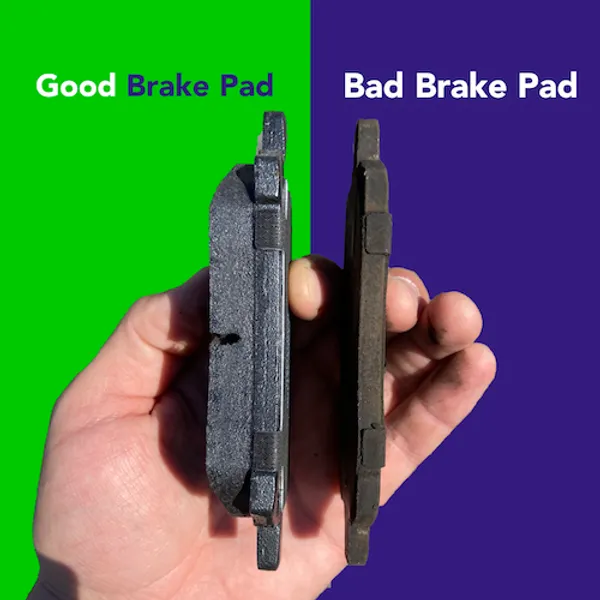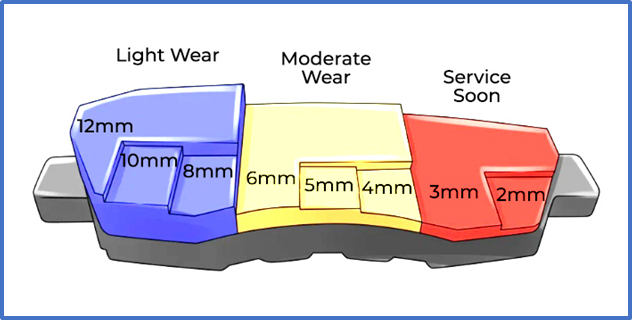


Brake pads are a crucial component of a vehicle's braking system, responsible for creating the friction necessary to slow down and stop the vehicle. Over time, these pads wear down due to regular use, and it's essential to recognize the signs of wear and replace them when necessary to ensure safe and efficient braking performance. This outline will provide a comprehensive overview of brake pad wear, including the signs to watch for, the potential causes of accelerated wear, and guidelines on when to replace brake pads.

Let's start with the main culprits behind brake pad wear:
| Issue | Causes |
|---|---|
| Uneven Brake Pad Wear | - Misaligned brake calipers or pads not sliding properly - Stuck or seized caliper pistons/slide pins - Variations in rotor thickness (disc thickness variation) - Improper brake pad installation |
| Excessive Brake Pad Wear | - Aggressive driving habits (hard braking, riding the brakes) - Carrying heavy loads or towing - Driving in stop-and-go traffic or hilly terrain - Poor quality or incorrect brake pad materials |
| Brake Pad Contamination | - Exposure to dirt, water, oil or grease - Brake fluid leaks - Rust or corrosion on brake components |
Uneven wear can be caused by a variety of issues, from misaligned calipers to stuck slide pins or even variations in rotor thickness. Excessive wear, on the other hand, is often the result of aggressive driving habits, heavy loads, or stop-and-go traffic. And then there's contamination, which can happen when your pads are exposed to dirt, fluids, or rust.
So, how do you know if your brake pads are wearing out? Well, the first step is a good old-fashioned visual inspection. Here's what to look for:
Brake pad thickness: Check if the pads are getting dangerously thin or below the minimum thickness specification.
Uneven wear patterns: Look for tapered pads, grooves on one side, or other signs of uneven wear.
Contamination: Glazed or cracked pads, deposits on the friction material.
Caliper issues: Sticking, uneven pad wear, fluid leaks.
Rotor issues: Grooves, hot spots, thickness variation.
Don't forget to listen for any abnormal noises during braking, like squealing or grinding. And if you feel vibrations, pulsations, or reduced braking performance during a test drive, it's time to get those brakes checked out.
Alright, so you've identified the issue. Now, let's talk about repair procedures:
Replace brake pads
Clean, lubricate or replace stuck caliper pins/bushings
Machine or replace rotors if excessively worn/grooved
Ensure proper brake pad installation and alignment
Replace brake pads with correct quality/material for driving conditions
Machine or replace rotors if necessary
Inspect and replace other worn brake components (calipers, hoses, etc.)
Replace contaminated brake pads
Clean or replace affected brake components (calipers, rotors)
Identify and fix source of contamination (fluid leaks, rust, etc.)
Throughout the repair process, be sure to follow the manufacturer's procedures to a T. Proper lubrication and cleaning methods are crucial, and don't forget to inspect related components like the suspension or wheels that could be affecting your brakes. And always, always perform a brake system bleed after any repairs to ensure optimal performance.

Prevention is key when it comes to brake pad wear. Here are some tips to keep your brakes in top shape:
Follow recommended brake inspection/replacement intervals
Regular brake fluid flushes
Periodic caliper cleaning and lubrication
On the driving front:
Avoid aggressive braking habits
Reduce loads and towing when possible
Allow brakes to cool after heavy use
Use quality brake parts designed for your vehicle
Brake pad replacement costs can vary widely depending on your vehicle and the quality of parts you choose. Here's a rough breakdown:
| Component | Average Cost |
|---|---|
| Brake pads (front or rear axle) | $50 - $150 per axle |
| Rotor resurfacing or replacement | $100 - $400 per axle |
| Caliper rebuild or replacement | $100 - $500 per caliper |
| Labor costs | $100 - $300 per axle |
While it may seem like a hefty investment, catching brake issues early through regular inspections can prevent more expensive repairs down the line. And when it comes to your safety on the road, cutting corners is never worth the risk.
So, there you have it, folks – the nitty-gritty on brake pad wear from a seasoned mechanic. Remember, proper maintenance and quality parts are key to keeping your brakes in tip-top shape. Happy and safe driving!
Squealing or grinding noises during braking, reduced braking performance, and a low brake pedal are common signs of worn brake pads. Visually inspecting the pads for minimum thickness and uneven wear patterns is also recommended.
Brake pad replacement intervals vary, but most mechanics recommend replacing them every 25,000 to 70,000 miles, depending on driving habits and conditions.
It's generally recommended to replace the brake rotors along with the pads, as new pads on worn rotors can lead to vibrations, reduced braking performance, and premature pad wear.
Aggressive driving habits like hard braking, riding the brakes, carrying heavy loads, and driving in stop-and-go or hilly terrain can all contribute to excessive brake pad wear.
Regular maintenance, including inspecting and replacing worn caliper pins, bushings, and other brake components, can help prevent uneven pad wear. Proper brake pad installation and alignment are also crucial.
Brake pad contamination occurs when the friction material is exposed to dirt, water, oil, grease, or rust, leading to reduced braking performance and premature wear.
Contaminated brake pads must be replaced, and the affected components (calipers, rotors) should be cleaned or replaced. The source of contamination, such as fluid leaks or rust, must also be identified and fixed.
A stuck caliper can cause uneven brake pad wear, reduced braking performance, and a dragging sensation while driving. It may also lead to premature pad wear on one side.
The cost of a complete brake job, including pads, rotors, and caliper work, can range from $300 to $800 or more per axle, depending on the vehicle and the quality of parts used.
While brake pad replacement is a common DIY task for experienced mechanics, it's crucial to follow the manufacturer's procedures carefully and have the proper tools and knowledge. If unsure, it's best to have a professional handle the job.

Sarah isn't your average gearhead. With a double major in Mechanical Engineering and Automotive Technology, she dived straight into the world of car repair. After 15 years of turning wrenches at dealerships and independent shops, Sarah joined MICDOT to share her expertise and passion for making cars run like new. Her in-depth knowledge and knack for explaining complex issues in simple terms make her a valuable asset to our team.



